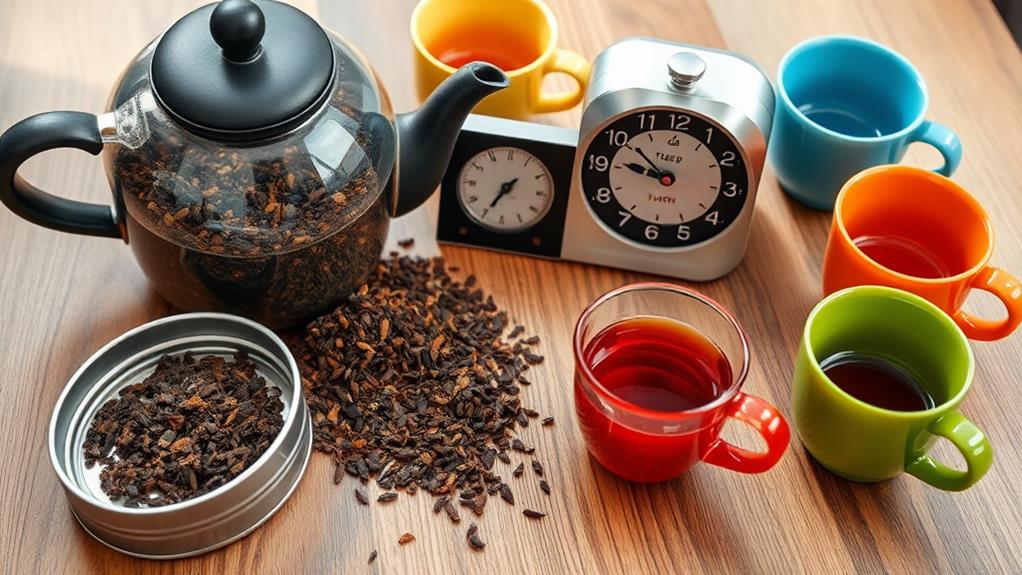You might be making some common mistakes with loose tea that affect your experience. First, using low-quality leaves can lead to a bland cup. Also, don't underestimate water temperature and quality; using fresh, clean water at the right heat is crucial. Ignoring steeping time can result in bitterness, while not measuring your tea properly can ruin flavor balance. Reusing tea leaves too much or brewing different types together can also spoil the taste. Lastly, skipping pre-warming your teapot and improper storage can diminish your brew's potential. Keep enjoying tea, and you're bound to discover more tips to enhance your enjoyment!
Using Low-Quality Tea
When you reach for a cup of tea, the quality of the leaves can make all the difference. Using low-quality tea can result in a bland experience that leaves you feeling unsatisfied. You might think all tea is created equal, but that's far from the truth!
The art of tea sourcing plays a crucial role in the flavor profiles you encounter. Sourcing high-quality leaves from trusted suppliers means you're tapping into a world of vibrant flavors and aromas, including the rich antioxidants found in premium varieties like antioxidants in tea.
Imagine sipping a cup where the rich notes of Darjeeling dance on your palate, or the bold essence of a well-crafted Assam warms your soul. When you choose premium tea, you're not just making a beverage; you're embarking on an adventure for your taste buds.
Low-quality tea often lacks the complexity and depth that makes each sip delightful. It's like choosing a plain cracker over a gourmet cheese platter—why settle for less?
Incorrect Water Temperature
Choosing high-quality tea is just the first step; the water temperature you use plays a vital role in unlocking the full potential of those leaves. If you brew your tea with water that's too hot or too cold, you're missing out on the vibrant flavors and aromas your tea has to offer.
Each type of tea, from delicate green to robust black, has its ideal water temperature that enhances its unique character. Understanding ideal brewing temperatures can greatly improve your tea experience, ensuring that each cup is brewed to perfection.
For instance, green teas thrive at a lower temperature, around 175°F (80°C), while black teas demand hotter water, typically around 200°F (93°C). Using the right temperature not only preserves the delicate compounds but also prevents bitterness and astringency that can ruin your experience.
Experimenting with different brewing techniques can elevate your tea game. Try using a thermometer or a kettle with temperature settings—these tools can help you hit the sweet spot every time.
Ignoring Steeping Time
When it comes to brewing the perfect cup of tea, don't overlook steeping time.
Different types of tea have specific steeping requirements that can significantly affect their flavor profiles. If you let your tea steep for too long, you might end up with a bitter taste that ruins the experience.
Knowing the ideal steeping durations for different types of tea can really elevate your enjoyment and keep those flavors just right!
For guidance on steeping temperatures, check out brewing guidelines.
Oversteeping Consequences
Ignoring steeping time can lead to a bitter cup of tea that no one wants to drink. Oversteeping can ruin the delicate flavors in your favorite brew, leaving you with a concoction that's more astringent than aromatic. You might notice some oversteeping signs like a strong, unpleasant taste, a darkened color, or even a strange aroma.
To help you understand the consequences of oversteeping, here's a quick reference table:
| Oversteeping Signs | Causes | Oversteeping Remedies |
|---|---|---|
| Bitter flavor | Too long steeping time | Add milk or sweetener |
| Dark color | High tea temperature | Dilute with hot water |
| Unpleasant aroma | Improper tea type | Brew a fresh batch |
| Astringent aftertaste | Incorrect leaf size | Blend with a milder tea |
| Loss of aroma | Old or stale tea leaves | Use fresh, quality tea |
Understanding these oversteeping signs and their remedies will enhance your tea experience. So, when you brew, keep an eye on that timer! Your taste buds will thank you.
Ideal Steeping Durations
Finding the right steeping duration is essential for unlocking the full potential of your tea. With so many types of tea out there, it's easy to feel overwhelmed. But don't worry! Understanding steeping techniques can turn you into a tea expert in no time.
Each type of tea has its own unique flavor profile that can be enhanced by proper brewing parameters, including steeping time and water temperature. Key brewing techniques ensure that you achieve the best results every time.
For black tea, aim for about 3 to 5 minutes. This duration brings out a bold flavor without bitterness.
Green tea, on the other hand, benefits from a shorter steep—just 2 to 3 minutes. Too long, and you'll lose that delicate taste.
Herbal variations often require a lengthier steep, usually around 5 to 7 minutes, allowing the flavors to fully develop. Remember, the key is to taste as you go. Feel free to experiment!
Using a timer can be a game-changer, but don't forget to trust your senses. You might discover that you prefer a specific type of tea brewed for a bit longer, or even shorter!
Not Measuring Tea Properly
Many tea drinkers overlook the importance of measuring their tea properly, which can lead to inconsistent flavors and disappointing brews. You might think that a pinch here or a scoop there's enough, but precision is key!
Proper measurements not only enhance flavor but also help you enjoy the exceptional health benefits of tea. Here are some essential tea measurement techniques to elevate your brewing game:
- Use a scale: Measuring by weight is the most accurate way to ensure proper tea ratios.
- Know your tea type: Different teas have varying densities, so adjust your measurements accordingly.
- Follow the guidelines: A general rule is one teaspoon per cup for most loose teas, but this can vary.
- Experiment: Don't be afraid to tweak the amount based on your taste preferences.
Getting your measurements right not only enhances flavor but also unlocks the full potential of your favorite brews.
By mastering proper tea ratios, you'll find that each cup can be a delightful experience rather than a hit-or-miss endeavor.
Reusing Tea Leaves Excessively
Reusing tea leaves can be a tempting way to save money and reduce waste, but doing it excessively can compromise your brew's flavor and quality.
While it's true that many tea leaves possess impressive tea leaf longevity, pushing their reuse too far can lead to a lackluster cup. When you steep the same leaves multiple times, essential oils and flavors diminish, resulting in a bland experience.
For optimal reuse, consider the type of tea you're using. Delicate green teas shine for just one or two steeps, while robust black teas can often handle three or four.
Keeping track of how many times you've reused your leaves helps maintain that delightful taste you crave.
It's worth noting that each steeping should be shorter than the last; this way, you'll extract the best flavors without overdoing it.
So, while it's great to be thrifty, don't forget that quality counts! By finding that sweet spot for reuse, you can enjoy a satisfying brew without sacrificing flavor.
Overlooking Water Quality
When you're brewing your favorite tea, the quality of the water you use can make a huge difference.
Fresh, clean water can enhance the flavor, while stale or hard water might leave your tea tasting flat or even bitter.
Importance of Freshness
While you might focus on the quality of your tea leaves, overlooking the importance of water quality can ruin your brewing experience. Freshness plays a crucial role in how your tea tastes, and your water choice is just as vital.
Here are four key freshness indicators you should consider:
- Source: Always use filtered or spring water for the best results. Tap water can contain chemicals that affect flavor.
- Temperature: Fresh, cold water brews better. Let it come to a boil before pouring it over your tea.
- Storage: Just like tea leaves, water should be stored properly. Keep it in a clean, sealed container to avoid contamination.
- Time: Use your water quickly. Stale water loses its freshness and can impact your tea.
Impact on Flavor
Many tea drinkers underestimate how much water quality affects flavor. You might think that any water will do, but the truth is, the right water can elevate your tea experience dramatically. Poor-quality water can mask delicate tea aromas and throw off the flavor balance you're striving for.
When you brew tea, the water acts as a canvas for the flavors and aromas to unfold. If your water is too hard or has a funky taste, it can clash with your carefully selected loose tea, resulting in a cup that's less than spectacular. Ideally, you want to use filtered or spring water that's clean and fresh.
The impact of water on tea isn't just about taste; it directly affects your overall enjoyment. Imagine sipping a cup of green tea with a hint of bitterness because of minerals in the water—it's not the delightful experience you want!
Brewing Multiple Types Together
Brewing multiple types of tea together might seem like a way to create unique flavors, but it often leads to a muddled cup. Different teas have distinct brewing techniques and flavor profiles, and when you mix them, you risk losing the vibrant characteristics that make each one special.
Here are four key reasons to think twice before combining teas:
- Flavor Balance: Each tea has its own ideal steeping time and temperature. Mixing them can throw off this balance, leading to over-extraction or under-extraction.
- Competing Aromas: Stronger flavors can overpower more delicate ones, masking subtle notes and aromas that you'd otherwise enjoy.
- Tannins and Astringency: Some teas contain higher tannin levels, which can create a bitter taste when brewed with lighter varieties.
- Caffeine Levels: Combining high-caffeine and low-caffeine teas can lead to unpredictable energy levels, which mightn't be what you want.
Instead of brewing multiple types together, focus on mastering each tea's unique attributes.
You'll discover a richer experience, and your taste buds will thank you!
Skipping Pre-Warming Teapots
Some tea drinkers overlook the importance of pre-warming their teapots, thinking it's an unnecessary step. But let me tell you, it's a game-changer! When you pre-warm your teapot, you're helping to maintain the optimal temperature of your brew. This is especially crucial for delicate teas, which can lose their flavor if cooled too quickly.
Different teapot materials, like porcelain, glass, or clay, have unique heat retention properties. By pre-warming, you ensure that your tea doesn't suffer from sudden temperature drops, allowing for a more consistent extraction of flavors. Imagine pouring hot water into a cold teapot—the shock can lead to a lackluster cup of tea!
The pre-warming benefits extend beyond just flavor. It also enhances the aroma, making your tea experience even more enjoyable. Plus, you'll impress your friends with your newfound tea wisdom.
Storing Tea Improperly
When it comes to storing tea, you might be making some key mistakes without even realizing it.
Exposing your tea to light and moisture can ruin its flavor, and using the wrong container can lead to stale leaves.
Let's explore how to keep your tea fresh and delicious for every cup you brew!
Light and Moisture Exposure
Exposing tea to light and moisture can quickly diminish its quality, making proper storage essential for preserving flavor and aroma.
If you want to keep your tea fresh and delightful, here are some key points to remember about light exposure and moisture control:
- Keep it Dark: Store your tea in a dark place, away from sunlight, as UV rays can degrade its taste and color.
- Seal it Tight: Always use airtight containers to prevent moisture from sneaking in. Even a little humidity can lead to mold or stale flavors.
- Cool and Dry: Find a cool, dry spot for your tea. Avoid places near stoves or dishwashers, where heat and steam can ruin your stash.
- Limit Airflow: Once you open your tea, try to use it up quickly. Frequent exposure to air can lead to oxidation, which dulls the vibrant flavors you love.
Incorrect Container Choice
Choosing the right container for your tea is crucial for maintaining its freshness and flavor. If you think any old jar will do, think again! The container material plays a significant role in how well your tea holds up over time.
Glass, for example, is great for visibility, but it can allow light to sneak in, damaging your precious leaves. Instead, opt for opaque, airtight containers made of metal or ceramic. These materials block out light and keep moisture at bay, ensuring your tea stays vibrant.
Lid functionality is another key factor. A tight-fitting lid is essential to prevent air from seeping in. Air can lead to oxidation, which dulls the taste of your tea. So, if your container has a flimsy lid, it's time for an upgrade!
Also, consider how you store your tea. Keep it in a cool, dry place away from heat sources. Proper storage can make all the difference in preserving the unique flavors and aromas that drew you to your favorite blends.
Neglecting Flavor Pairings
Neglecting flavor pairings can significantly diminish your tea experience. When you brew your loose tea, it's essential to consider how different flavor profiles can enhance your cup. By ignoring complementary ingredients, you might miss out on a world of exciting possibilities.
Here are four innovative pairings to try:
- Green Tea + Mint: The fresh notes of mint can elevate the grassy undertones of green tea.
- Earl Grey + Lavender: The citrusy bergamot blends beautifully with floral lavender for a calming effect.
- Chai + Vanilla: Adding vanilla softens the spice, creating a warm and inviting cup.
- Oolong + Citrus: A splash of lemon or orange brightens oolong's complex flavors.
Experimenting with these combinations can transform your tea time into a delightful adventure.
Don't be afraid to play around with different ingredients; the right pairing can create a harmonious blend that excites your taste buds.
So, next time you brew, think outside the box! Embrace the art of flavor pairings, and watch your tea experience soar to new heights.
It's all about discovering what works for you, and who knows—you might just find your new favorite blend!
FAQ
Can I Mix Different Types of Tea for Better Flavor?
Absolutely, you can mix different types of tea for better flavor! Experimenting with flavor combinations can lead to delightful tea blending experiences. Just remember to balance the strengths of each tea for the best results.
How Can I Enhance the Health Benefits of Loose Tea?
To enhance health benefits, you'll want to balance brewing temperature with steeping time. Too hot or too long can diminish nutrients, while precision unlocks the full potential of flavors and health advantages. Embrace experimentation!
What Are the Best Storage Containers for Loose Tea?
To maximize freshness, choose airtight glass, stainless steel, or ceramic tea containers. These materials provide optimal storage conditions by blocking light and air, ensuring your loose tea retains its flavor and health benefits longer.
Is It Safe to Drink Loose Tea Past Its Expiration Date?
Drinking loose tea past its expiration date can be safe, but you might notice diminished flavor and freshness. It's best to trust your senses—if it smells and tastes good, enjoy innovatively without worry!
Can I Reuse Tea Leaves for Different Types of Tea?
You can reuse tea leaves, but tea leaf reusability varies by type. Adjust steeping times for optimal flavor—shorter for delicate teas, longer for robust ones. Experimenting can lead to innovative brewing experiences you'll love!
Final Thoughts
Now that you know the top mistakes tea drinkers make, you can elevate your brewing game! Did you know that nearly 80% of tea drinkers don't pay attention to water temperature? That's a big missed opportunity for flavor! By choosing high-quality leaves, measuring correctly, and steeping just right, you can unlock a world of deliciousness in every cup. So, grab your favorite loose tea, and let's make your next brew the best one yet!



